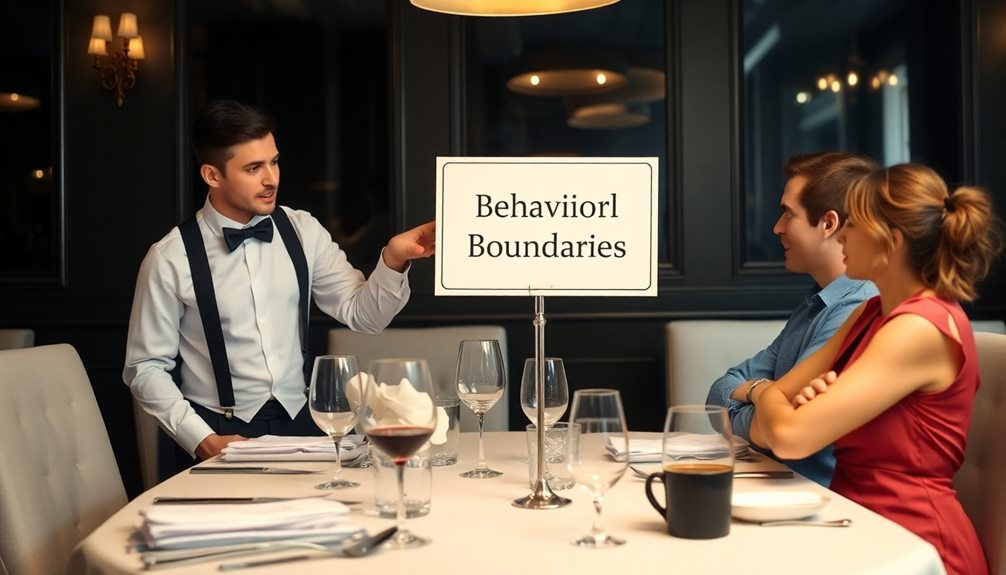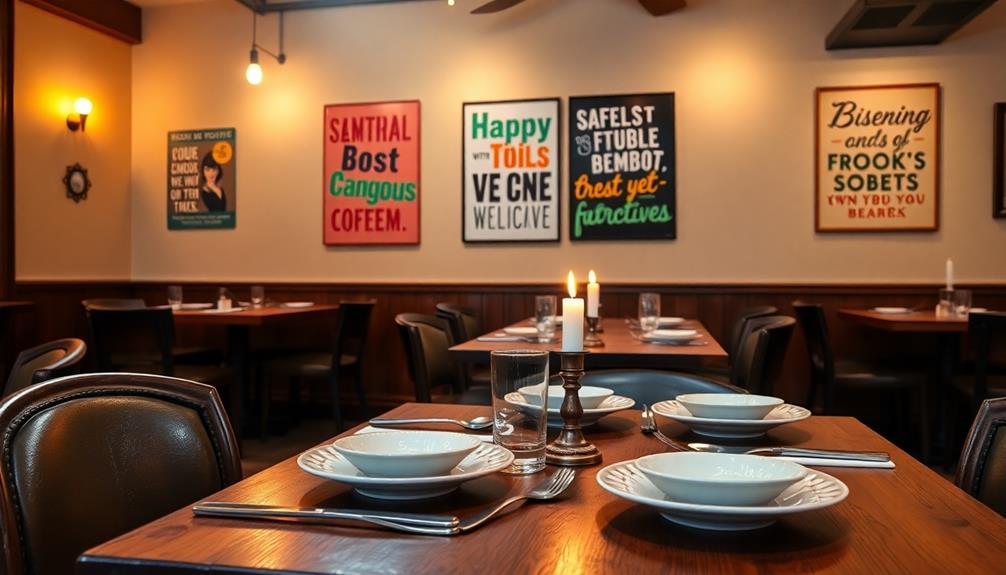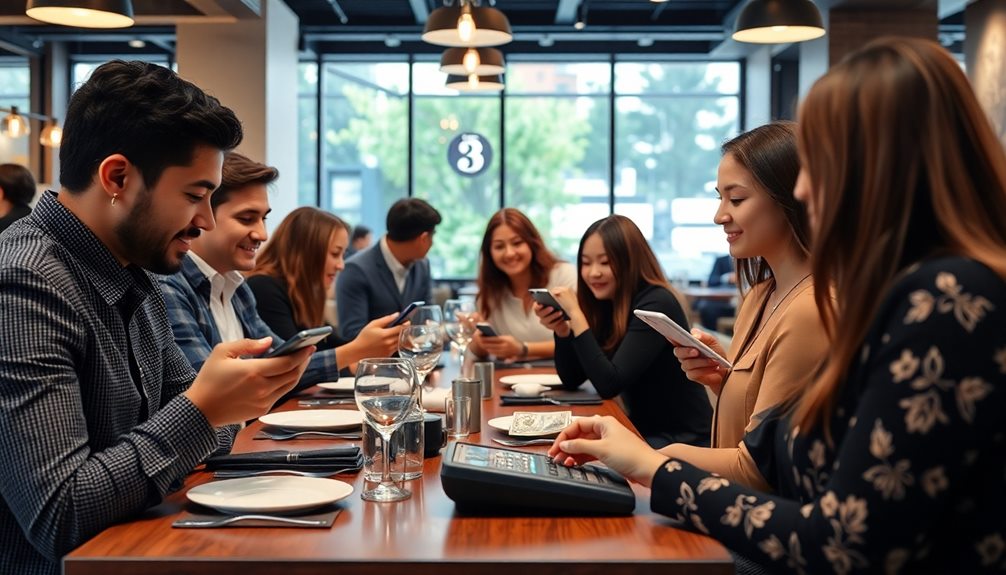Handling difficult restaurant customers starts with active listening. Give them your full attention and paraphrase their concerns to show you understand. Keep your tone calm and use their name to personalize the interaction, fostering a connection. Empathy goes a long way—validate their feelings and stay composed, even in tense situations. Offering solutions that directly address their discomfort helps regain satisfaction. Don't forget to check on surrounding diners too. Finally, setting clear behavioral guidelines guarantees everyone knows what to expect. There's so much more to explore in the art of customer service that can transform your approach.
Key Takeaways
- Practice active listening to fully understand customer concerns and validate their feelings through paraphrasing and summarizing.
- Maintain a calm demeanor and use a soft tone to de-escalate tense situations and foster non-confrontational dialogue.
- Personalize interactions by addressing customers by name and referencing past visits to build rapport and trust.
- Offer effective solutions that directly address customer discomfort and follow up to reinforce your commitment to their satisfaction.
- Establish clear behavioral guidelines and train staff to recognize and manage unacceptable conduct for a safer dining environment.
Active Listening Techniques

Active listening is fundamental when dealing with difficult restaurant customers. When a customer approaches you with complaints, it's essential to give them your full attention. Minimize distractions and maintain open body language to create a welcoming atmosphere. This shows that you genuinely care about their concerns.
Use their name during the conversation; it personalizes the interaction and makes them feel respected. Paraphrasing their complaints not only clarifies your understanding but also allows the customer to feel validated. When they see you're actively engaged, it can greatly ease the tension.
Expressing sympathy is important. Acknowledge their feelings with validating statements like, "I understand how frustrating this must be for you." This builds rapport and can help de-escalate the situation.
Summarizing the main points of their complaint guarantees you're both on the same page, paving the way for a constructive dialogue.
Maintaining Composure

When dealing with difficult customers, staying calm and collected is key to preventing escalation.
Practicing deep breathing and using a soft tone can help you manage your emotions and create a more positive interaction.
Stay Calm and Collected
Maintaining composure during challenging customer interactions is essential for effective resolution. When faced with difficult customers, you need to stay calm. Your ability to remain composed not only helps prevent escalation but also sets a positive example for the customer, promoting a more productive dialogue.
A soft tone of voice is critical; it helps de-escalate tension and encourages customers to respond in kind, creating a calmer atmosphere for resolution.
As you engage in customer service, it's important to avoid personal reactions and maintain neutrality. This approach allows you to address the issue at hand without becoming emotionally involved in the conflict.
Practice Deep Breathing
In high-pressure situations, your ability to practice deep breathing can be a game-changer for maintaining composure. When dealing with difficult customers, consider these three key benefits of deep breathing:
- Lower Stress Levels: Deep breathing techniques can help reduce anxiety and lower your heart rate, allowing you to remain calm.
- Clearer Thinking: Investing just a few minutes in deep breathing promotes better problem-solving, enabling you to think clearly when responding to upset customers.
- Emotional Resilience: Regular practice of deep breathing enhances your capacity to handle challenging situations in the future.
To practice deep breathing effectively, inhale deeply through your nose for a count of four, hold for four, and exhale through your mouth for another count of four. This simple technique regulates your emotional responses and promotes calmness, making it easier to maintain customer satisfaction.
Before engaging with a frustrated customer, take a moment to breathe deeply. This will help you avoid impulsive reactions and foster more constructive communication.
Use Soft Tone
Amid the chaos of a busy restaurant, your voice can be a powerful tool in managing difficult customer interactions.
Using a soft tone not only helps to create a calming environment but also encourages customers to mirror that calmness. This mutual regulation can greatly affect the emotional atmosphere of the interaction, allowing for a more respectful dialogue.
Maintaining a calm demeanor while speaking softly can prevent the escalation of emotions, which is key for effective problem-solving and conflict resolution.
When you address customer concerns with a gentle voice, you demonstrate attentiveness and care, reinforcing the customer's feeling of being valued and heard.
Empathy Without Insincerity

When dealing with difficult customers, showing authentic emotional connection is key.
You can express genuine understanding by actively listening and validating their feelings without overdoing it.
Using their name and maintaining a calm demeanor can help you connect sincerely while keeping the situation professional.
Authentic Emotional Connection
Creating an authentic emotional connection with customers is essential for effective service, especially in challenging situations. By fostering genuine empathy, you can turn a frustrating experience into a positive interaction. This approach aligns with the principles of mindfulness techniques that enhance present-moment awareness and reduce stress.
Here are three key strategies to help you build that emotional connection:
- Active Listening: Focus on what the customer is saying. This shows that you value their concerns and are genuinely interested in resolving their issues.
- Use Their Name: Incorporating the customer's name in the conversation personalizes the interaction, making them feel acknowledged and valued.
- Maintain Calm Demeanor: Your body language and tone matter. Staying calm can help de-escalate tense situations and build trust.
Genuine Understanding Expressions
Genuine understanding expressions are essential in maneuvering difficult interactions with restaurant customers. When faced with a frustrated diner, your first step is to employ genuine expressions of empathy. Actively listen to their concerns without interrupting, showing that you value their feelings. Verbal affirmations like, "I understand how frustrating that must be for you," can help validate the customer's emotions, fostering a connection.
Maintaining a calm demeanor is vital. Use a soft tone, as this reduces the risk of sounding patronizing or insincere. It's important to avoid overly dramatic responses; customers can often sense when your empathy feels disingenuous.
Instead, balance your sympathy with professionalism by acknowledging their feelings while steering the conversation toward solutions. This approach creates a supportive and productive dialogue, allowing you to address the customer's issues effectively.
Personalizing Customer Interactions

Personalizing customer interactions is essential for enhancing the dining experience and building lasting relationships. When you focus on personalizing your approach, you can greatly improve how customers feel during their visit.
By incorporating techniques to build passion and motivation, you can create a more engaging environment for both staff and customers. Here are three key strategies to take into account:
- Use Names: Addressing customers by their names fosters respect and enhances communication.
- Reference Past Visits: Mentioning previous experiences or preferences shows that you value them as individuals.
- Ask Open-Ended Questions: Encourage customers to share their needs and feelings, allowing for a more tailored interaction.
By incorporating these strategies, you can demonstrate genuine empathy. For instance, when a customer voices a concern, listen attentively and tailor your response to their specific issue.
Acknowledging their feelings and validating their experiences can effectively de-escalate conflicts and create a positive atmosphere.
The Power of Tone

The right tone can make all the difference when handling difficult restaurant customers. Speaking in a calm, lower tone helps de-escalate tense situations, as studies show that individuals often mirror the vocal tone of those they're communicating with.
This mirroring can create a more serene atmosphere, making it easier for customers to engage constructively. In relationships, such as those with customers, emotional alignment is imperative; a mindful approach to communication can foster a more positive interaction, similar to the techniques used in maintaining emotional alignment during conflicts.
Using a soft voice encourages customers to respond in kind, paving the way for a dialogue that's less confrontational. By maintaining a neutral and steady tone, you demonstrate professionalism, which is vital in preventing further escalation of the customer's emotions during a complaint.
Effective use of tone also conveys empathy and understanding, making customers feel heard and validated—key components in resolving their concerns.
Variations in your vocal tone can communicate sincerity and reassurance, which are fundamental in restoring a customer's trust and satisfaction.
Clarifying Customer Concerns

Maintaining a calm tone lays the groundwork for understanding customer concerns. When you engage with a frustrated customer, it's essential to clarify their issues effectively. Here are three key strategies to enhance your approach:
- Active Listening: Show that you're genuinely paying attention. Paraphrase their concerns to confirm your understanding, allowing them to clarify any misunderstandings.
- Validate Feelings: Everyone wants to feel heard. Acknowledge their emotions and summarize their complaints to demonstrate empathy, which can help ease tension.
- Ask Open-Ended Questions: Encourage customers to elaborate on their issues. Questions like "Can you tell me more about what happened?" provide a clearer picture of their dissatisfaction.
Using the customer's name throughout the conversation also fosters a personal connection, making them feel valued. As you repeat back what you've heard, it gives them the chance to correct any inaccuracies in your understanding.
Offering Effective Solutions

When addressing a customer's concerns, presenting effective solutions quickly can make all the difference. Whether you're dealing with an angry customer or a minor issue, your focus should be on their specific needs rather than internal problems.
Start by confirming that your solution directly addresses their discomfort. This not only shows you understand their frustration but also makes them feel valued.
Collaborate with the customer on potential solutions. This empowers them and fosters satisfaction in the resolution process. For instance, if they're unhappy with their meal, offer to replace it with something they prefer or provide a reasonable amount off their bill.
Utilizing customer feedback is essential. It helps you refine your offerings and guarantees that your solutions are relevant and effective for future interactions.
After providing a solution, follow up to reinforce your commitment to customer satisfaction. Ask if they're happy with the resolution and if there's anything else you can assist with.
Managing Surrounding Patrons

Handling conflicts with difficult customers isn't just about resolving their issues; it's also about keeping the dining experience pleasant for everyone else. Here are three key strategies to contemplate when managing surrounding patrons:
- Monitor Reactions: Keep an eye on the reactions of nearby diners during any conflict. This helps you gauge their discomfort and guarantees a positive dining atmosphere for all guests.
- Provide Extra Attention: After an incident, offer extra attention and kindness to the tables affected. This can help restore their dining experience and let them know you care about their comfort.
- Acknowledge Disruption: Recognize the disruption caused by the outburst to other diners. By addressing the situation swiftly, you reinforce your commitment to a pleasant dining environment.
Incorporating these strategies shows that you value all patrons, not just the ones in conflict.
Small gestures, like offering complimentary desserts, can go a long way in compensating for any discomfort they experienced.
Ultimately, your goal should be to manage surrounding patrons effectively, guaranteeing everyone leaves with a positive dining experience.
Setting Behavioral Boundaries

To guarantee a positive dining experience for everyone, setting clear behavioral boundaries is essential. Start by establishing guidelines that detail acceptable conduct within your restaurant. Communicate these boundaries to customers upon arrival, making it clear that disruptive behavior won't be tolerated.
Train your staff to recognize and address unacceptable behavior promptly. Provide them with the authority to intervene when necessary, promoting they feel supported in maintaining a peaceful atmosphere.
Consider implementing a policy for addressing repeat offenders, which may involve warnings and potential removal from the premises. This not only protects your staff and other patrons but also reinforces your commitment to a respectful dining environment. Regularly review and reinforce these boundaries with your team to promote consistent enforcement.
Here's a simple framework to guide your approach:
| Behavior | Acceptable Conduct | Unacceptable Behavior |
|---|---|---|
| Volume | Speaking at a normal level | Yelling or disruptive noise |
| Interaction | Polite conversation | Harassment or aggressive comments |
| Respect for Space | Maintaining personal space | Invading others' personal space |
| Dining Etiquette | Using utensils properly | Throwing food or causing a mess |
| Dispute Resolution | Calmly discussing issues with staff | Escalating conflicts aggressively |
Frequently Asked Questions
How to Deal With Difficult Customers in a Restaurant?
When dealing with difficult customers, listen actively to their concerns, stay calm, and use their name to build rapport. Offer practical solutions that address their needs, and make certain you're prepared through training and role-playing scenarios.
How to Deal With Rude Restaurant Customers?
When you encounter rude customers, listen actively without interrupting. Stay calm and use their name to personalize the conversation. Apologize sincerely for their discomfort and set boundaries if they continue to be disrespectful.
How Do You Handle a Very Difficult Customer?
When you handle a very difficult customer, listen actively to their concerns, stay calm, use their name, apologize sincerely, and offer solutions. If needed, set boundaries to maintain a comfortable environment for everyone.
How Do You Handle Rude Difficult Customers?
Dealing with rude customers can feel like wrestling a bear. Stay calm and listen actively; use their name to personalize the interaction. Apologize sincerely and set boundaries if their behavior escalates. Your professionalism shines through.
Conclusion
Maneuvering difficult restaurant customers is like steering a ship through stormy waters. By actively listening and maintaining your composure, you can transform a turbulent situation into a smooth sailing experience. Show genuine empathy, personalize your interactions, and clarify concerns to create a connection. Use a calm tone and offer effective solutions, while managing the atmosphere around you. Remember, setting clear behavioral boundaries is essential for keeping your ship on course. With practice, you'll master these challenging waters with ease.









